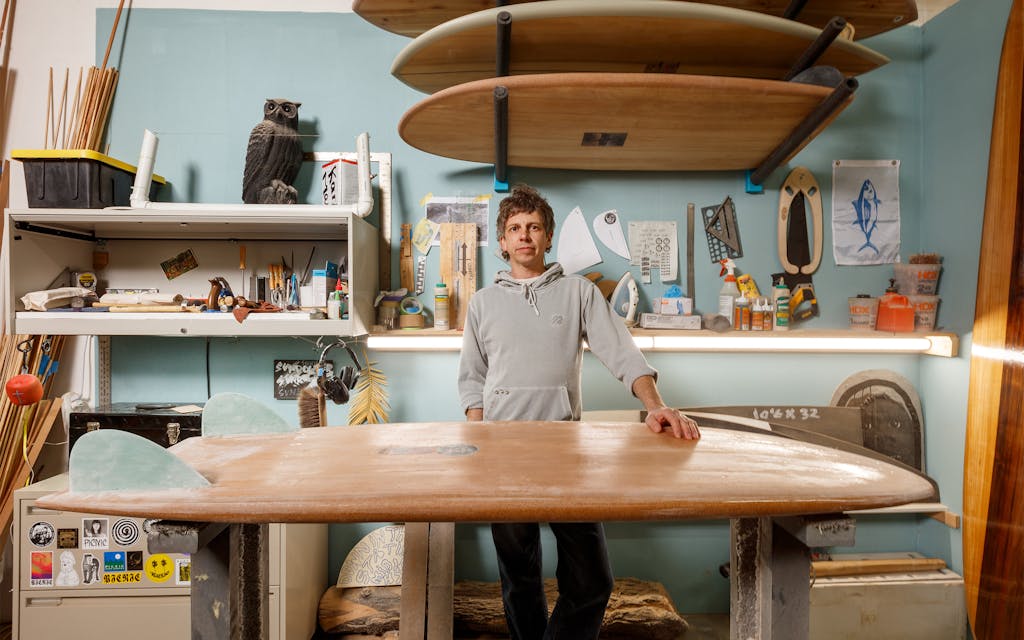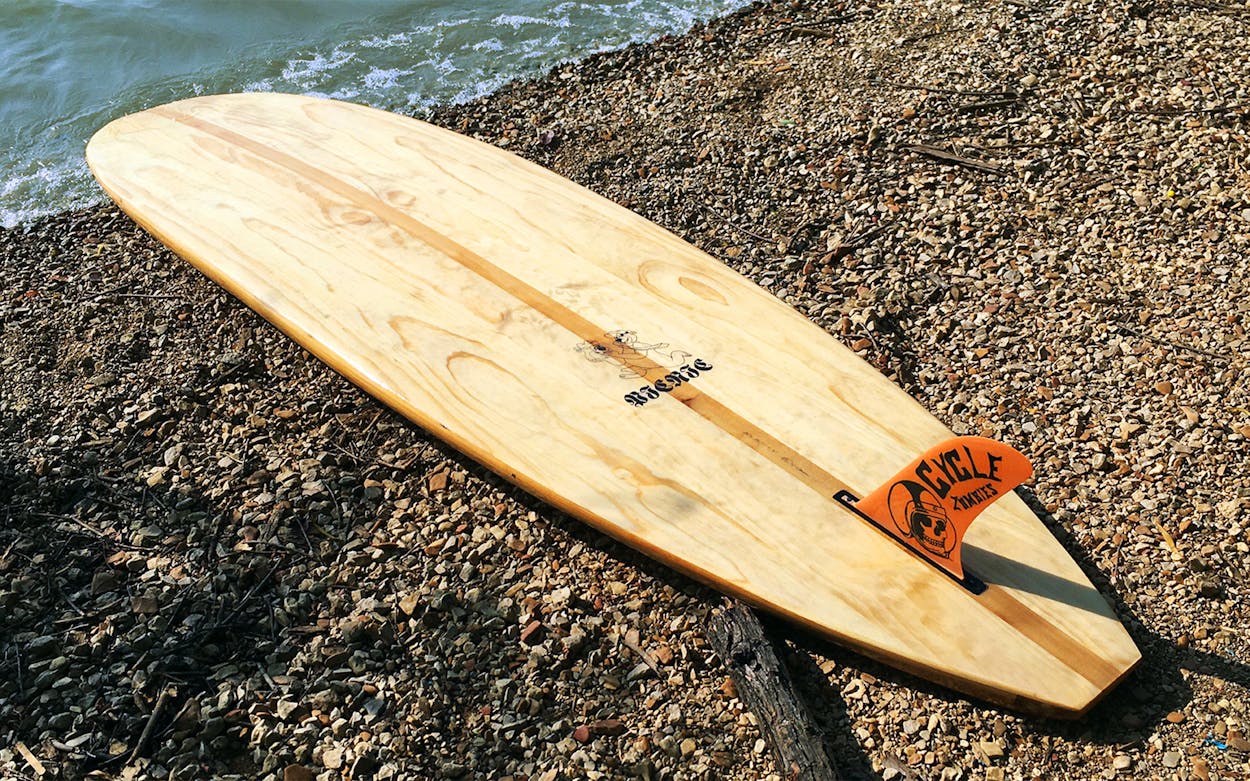The first surfboards, Matt Warshaw writes in The History of Surfing, were “likely banged together . . . with no more godly thoughts than a woodcrafter making a door.” Over the hundreds of years since, boards have evolved from basic wooden logs to dynamic shapes with cork rails and affixed fins; today, polyurethane foam boards dominate the waves. In Dallas, four hours and change from the ocean, artist Gregory Ruppe is getting back to traditional surfers’ woodcraft. But with his emphasis on sustainable materials and punk-art design in his hand-built, hollow-core wooden boards, Ruppe has plenty of godly thoughts.
Ruppe grew up skateboarding in Houston, but it wasn’t until high school that a crush got him to pick up a surfboard and transfer his balance skills to the water. He’s surfed along the Texas coast ever since, making frequent trips to California, Japan, and Mexico for good swells. When pandemic lockdown began and all art events were placed on hiatus, the artist, who has served as the director of exhibitions for the contemporary art space the Power Station since 2013, found himself landlocked by travel restrictions. Desperate to be out on a body of water, he crafted his own wooden paddleboard to use on local lakes. “With a long history of woodworking and a stubborn DIY attitude, I made my first ten-foot paddler,” says Ruppe. That act reignited an interest in both research and object-making. He quickly switched to producing surfboards as Picnic Surf Shapes.
In keeping with his dedication to sustainability, Ruppe builds his boards out of reclaimed wood and materials grown in the U.S. “You could have two identical shapes in your quiver [of boards] that behave very differently because of the woods they are made from,” he says. “The material is very exciting in that regard—endless possibilities.” Lighter woods, such as western redcedar, allow boards to be more responsive to a rider’s movement. Poplar provides more stability, offering an advantage in choppy waters. Picnic’s boards, which start at $1,800, are also coated with a plant-based epoxy resin as opposed to the typical petroleum-based finish.
Drawing inspiration from previous generations of shapers, Ruppe produces most traditional shapes and sizes, from shorter fish boards with tails to logs and longboards with blunt noses. “I want to make boards that span the decades—from the beauty and heritage of early wooden logs, to the experimentation in shape and approach of the 1960s, to the punk aesthetics and attitudes I grew up with,” he says.

“Punk aesthetics” play a big role in Picnic’s visual branding; boards are decorated with cartoonish risograph prints. You can ride on a nine-foot longboard printed with Yogi Bear talking on the telephone printed next to the phrase “this machine kills fascists” or a five-eight fishtail featuring Yogi Bear’s face on a tiger’s body. (Not all the boards feature Yogi. Some say “indeterminacy is not the end of history but that node in which many beginnings lie in wait,” a quote from Anna Lowenhaupt Tsing’s environmentalist and anticapitalist exploration The Mushroom at the End of the World.) Along with politically motivated surfboards, Ruppe makes a full line of objects for use on land, such as graphic tees, tote bags, and koozies made from recycled wetsuits that directly benefit the Galveston chapter of the Surfrider Foundation, which works to keep the ocean and coastline clean.
In February, Ruppe opened a brick-and-mortar Picnic shop right next to the Power Station. He’s been educating Texans ever since. “People [have] seemed more surprised to learn that there is actual surf in Texas than to find boards made in Dallas,” he says. He designed the annex, which he says combines elements of traditional wooden Japanese teahouses and metal visitor centers found throughout Texas State Parks. The tiny space functions as a surf shop and an art gallery, with boards and works on display side by side. Ruppe terms it “a surf brand, a research lab, and a platform for experimentation and collaboration.”
The art initiative, known as Picnic Curatorial Projects, launched this March. In partnership with Galveston artist group Rising Tides Projects, Picnic presented “Disappearing Acts,” a group show of objects such as T-shirts and vases with an undone punk feel. AZN Clam, on view through July 1, is artist and surfer Amy Yao’s exploration of anti-Asian racism and xenophobia, depicted through sculptures made from the invasive species of freshwater clam commonly referred to as Asian Clam.
This summer, Picnic and Rising Tides will copresent a series of pop-up shops in Galveston, offering boards and other products along the coast. This project will serve as a kickoff in advance of Picnic’s new downtown Galveston storefront, opening this June. The new outfit will provide more direct access to Texas surfers. Best of all, it will place Ruppe closer to ocean air and breaking waves.
- More About:
- Style & Design
- Art






